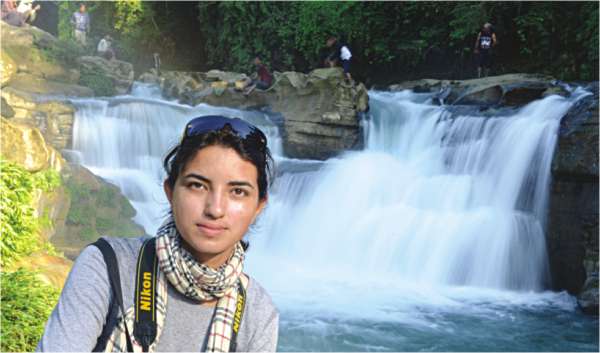Bridging the Gap
Watson Fellow in Bangladesh!
Safa Lamia Ahmed
Afshin Alaf Khan, the Watson fellow who arrived in Bangladesh, giggled between her spoonfuls of ice cream, as I pondered upon the questions I had in mind for her.
Watson scholarship is a one-year grant for independent study and travel outside United States awarded to graduating seniors nominated by participating institutions. This scholarship is granted to enhance the students' capacity for resourcefulness, imagination, openness, and leadership, and to foster their humane and effective participation in the world community. Recipients are forbidden from entering United States and their home country for a year. They are granted US $ 25,000 (per fellow) to spend while traveling in pursuit of their projects. The project theme is chosen by the fellows themselves. The topic Afshin chose was a thesis on individuals who facilitate education for females even through difficult times. When I asked what inspired her to choose this topic, she replied it was her mother who went through hard times in teaching Afshin and her siblings.

Afshin Alaf Khan, the Watson fellow in Bangladesh.
Afshin did not know anyone in Bangladesh. She was alarmingly overwhelmed with the thoughts of going to a foreign country she did not know much about. She was worried about the language barrier and was doubtful of her safety. She surfed the internet in search of places in Bangladesh where she could live cheaply as a tenant or for free. Meanwhile, she informed her friends about her situation. Two of her friends knew Nabila Idris, Founding President of CommunityAction (CA), a student-run non-profit organisation, and they suggested Afshin to get in touch with her. Later on Nabila provided Afshin with the accommodation and other assistance for her project.
Afshin was then introduced to the student volunteers or Actioneers of the organisation who helped her with everything she needed. She soon discovered that CA had created its own niche in community service as it aspired to build moral, influential, and professional human beings of the universe and good citizens of Bangladesh, who would believe in a leadership that is collaborative and accessible to all people.
Meeting new people, befriending them, learning about their ways of living, and witnessing how they were facilitating education for females going through tough times formed a significant part of her project. When asked about how she managed to track the people who formed the foundation of her project, she narrated how she met five people through some of CA's projects and Actioneers. Four of them were girls- Ayesha, Jahan, Shamima, and Kona, and the other one was Doctor Ibrahim Kholilullah.
Ayesha, who is eleven years old, was eager to study, but unfortunately inflicted with poverty. Although she got admitted to a school through the diligence and determination of the members of CA, she had to face obstacles as the school authority refused to take her in, mentioning that she was too poor to adjust with the other kids. CA's members were responsible for mentoring her, negotiating with the school authorities on her behalf, and evaluating her performance. Jahan is a visually-impaired student, who received tremendous support from CA, which enabled her to attend classes. Kona is a girl of around 10, who despite her age runs a stall in trolleys and yet studies. Shamima is very poor and since her father is ill, her mother has to work hard to make their ends meet and educate her child at the same time. Dr Ibrahim Kholilullah did a lot to help the people in Bogra, like setting up a big school for the children at the village and teaching sewing to many women.
The CA actioneers escorted Afshin and worked as translators, making it easier for her to complete.
As for recreation, Actioneers took Afshin to witness Grammo Eid (Eid in a village), which she described as the most memorable Eid. Playing games such as water-gun wars, sight-seeing, watching the beautiful sunset by the river-side, star-gazing at night, arm-wrestling and cooking were part of her recreation. At the village, she also enjoyed barbecue followed by fireworks.
It was a remarkable experience for Afshin and the people of Bangladesh. Afshin was able to absorb the culture of Bangladesh and take it back to her home country. Young people should host such guests from abroad. This will encourage the culture of hosting foreign students as well as tourists in Bangladesh, expanding mutual co-operation between countries and boosting the economy of Bangladesh through tourism and other forms of foreign investment
(The writer is a student of Grade 12, Mastermind School and a member of CommunityAction.)
DID YOU KNOW?
Leela Majumdar
 |
|
Author Leela Majumdar was born on 26 February 1908 to Surama Devi and Pramada Ranjan Ray. Leela spent her childhood days in Shillong, where she studied at the Loreto Convent. In 1919, her father was transferred to Calcutta and she joined St. John's Diocesan School from where she completed her matriculation examination. She ranked second among the girls in the examinations in 1924. She stood first in English (literature) both in her Honours (graduation) and Master of Arts examination at the University of Calcutta. The family she belonged to made a notable contribution towards children's literature. She joined Maharani Girls' School at Darjeeling as a teacher in 1931. On an invitation from Rabindranath Tagore, she went and joined the school at Santiniketan, but she stayed only for about one year. She joined the women's section of Asutosh College in Calcutta but again did not continue for long. Thereafter, she spent most of her time as a writer. After two decades as a writer, she joined All India Radio as a producer and worked for about seven-eight years. Her first story, Lakkhi chhele, was published in Sandesh in 1922 and was also illustrated by her. The children's magazine in Bengali was founded by her uncle, Upendrakishore Ray Chaudhuri in 1913 and was later edited by her cousin Sukumar Ray for sometime after the death of Upendrakishore in 1915. Together with her nephew Satyajit Ray and her cousin Nalini Das, she edited and wrote for Sandesh throughout her active writing life. Until 1994 she played an active role in the publication of the magazine.
Information Source: Internet
|
|
|
